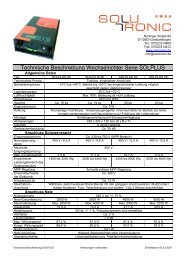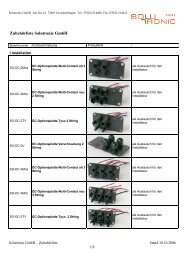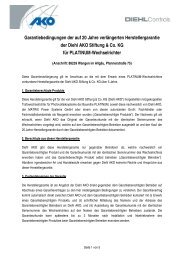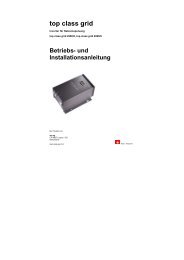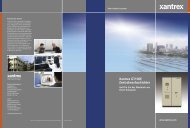General Installation Manual - Better Energy AG
General Installation Manual - Better Energy AG
General Installation Manual - Better Energy AG
You also want an ePaper? Increase the reach of your titles
YUMPU automatically turns print PDFs into web optimized ePapers that Google loves.
GENERAL SAFETY<br />
● The appropriate material should be<br />
Follow all permission, installation used for mounting hardware to prevent<br />
and inspection requirements. the module frame, mounting structure,<br />
● Before installing modules, contact the and hardware itself from corrosion.<br />
appropriate authorities to determine ● Install modules where they are not<br />
permissions, installation, and inspection<br />
requirements which should be followed.<br />
shaded by obstacles like buildings and<br />
trees. Especially pay attention to avoid<br />
● Electrically ground modules for all partially shading the modules by objects<br />
systems of any voltage. If not otherwise during the daytime.<br />
specified, it is recommended that ● Please contact your SANYO<br />
requirements of the latest National authorized representative with<br />
Electrical Code (USA) or Canadian Electric questions regarding mounting profiles<br />
Code (Canada) or other national or for modules.<br />
international electrical standards be used. Notes on <strong>Installation</strong><br />
● Be sure that the construction or structure ● Clearance between the module<br />
(roof, façade, etc.) where the modules are<br />
being installed, has enough strength. For<br />
frame and the mounting surface is<br />
required to allow cooling air to circulate<br />
modules mounted on roofs, special around the back of the module. This<br />
construction or structures may be required also allows any condensation or<br />
to help provide proper installation. Both moisture to dissipate. The module<br />
roof construction and module installation<br />
design have an effect on the fire resistance<br />
of a building. Improper installation may<br />
should never be sealed to the mounting<br />
surface with sealant that prevents air<br />
from circulating under the module.<br />
contribute to fire hazards. Additional ● To satisfy the UL fire class C rating<br />
devices such as ground fault, fuses, and<br />
disconnects may be required.<br />
for the modules, the recommended<br />
standoff height is 4 inches minimum. If<br />
● Do not use modules of different other mounting methods are used, this<br />
· specifications in the same system. may effect the fire class rating.<br />
● Follow all safety precautions of other<br />
Standard Operating Condition<br />
system components used.<br />
SANYO recommends that modules be<br />
operated under Standard Operating<br />
Conditions (SOC).<br />
UL Listing Information:<br />
To satisfy UL requirements, when<br />
installing the modules, be sure to:<br />
1) Use only stranded or solid copper<br />
single –conductor type UF cable or<br />
USE cable, rated sunlight resistant, for<br />
modules and interconnect wiring that<br />
is exposed to weather.<br />
2) Observe the requirements described<br />
in sections labeled INSTALLTION and<br />
SPECIFICATIONS.<br />
3) Grounding of the module frame is<br />
required. When ground wires greater<br />
than 6mm 2 (No.10 AWG) are required,<br />
the installer will need to provide<br />
suitable terminal connectors.<br />
INSTALLATION<br />
<strong>General</strong><br />
● Please read this guide completely<br />
before installation or use of the modules.<br />
This section contains electrical and<br />
mechanical specifications needed before<br />
using your SANYO PV modules.<br />
● Modules should be firmly fixed in<br />
place in a manner suitable to withstand<br />
all expected loads, including wind and<br />
snow loads.<br />
● Do not drill additional mounting holes<br />
in the module frames, as it will void the<br />
warranty.<br />
14<br />
<strong>Installation</strong> (reference)<br />
27 27<br />
Metal fitting<br />
(4 places)<br />
M6 Nut<br />
Spring washer<br />
Flat washer<br />
Metal fitting<br />
M6 Bolt/setscrew<br />
2<br />
f 8<br />
Mounting<br />
Structure Rail<br />
Metal fitting<br />
Mounting Structure Rail<br />
An installation location with conditions<br />
beyond SOC or with other Special<br />
Conditions (see below) should be avoided.<br />
SOC of SANYO modules is as follows:<br />
1. Standard Operating Conditions<br />
(1) The modules should be operated only<br />
in terrestrial applications. No space or<br />
other Special Conditions (see below).<br />
(2) The ambient temperature should be<br />
within –20℃ (-4 ° F) to 40℃ (104 ° F).<br />
(3) The relative humidity should be<br />
within 45% to 95%.<br />
(4)The installation place should be less<br />
than 1,000m (3,280ft) above sea level.<br />
<strong>Installation</strong>s more than 1,000m (3,280ft)<br />
are allowed only if the wind pressure<br />
load for a module is less than<br />
2,170N/m 2 (45PSF).<br />
Module<br />
Mounting Structure Rail<br />
2. Special Conditions<br />
( 1 ) The ambient temperature and<br />
installation place are different from SOC.<br />
(2) The salt damage is heavy at the<br />
installation place.<br />
(3) The hail and snow damage is heavy<br />
at the installation place.<br />
(4) The sand and dust damage is heavy<br />
at the installation place.<br />
(5) The air pollution, chemically active<br />
vapors, acid rain, and/or soot, etc. are<br />
heavy at the installation place.<br />
This referential figure is for HIP-xxxBA3 modules.<br />
Solar Module<br />
Solar Module<br />
End of Module Between Modules<br />
Figure 1. <strong>Installation</strong>





